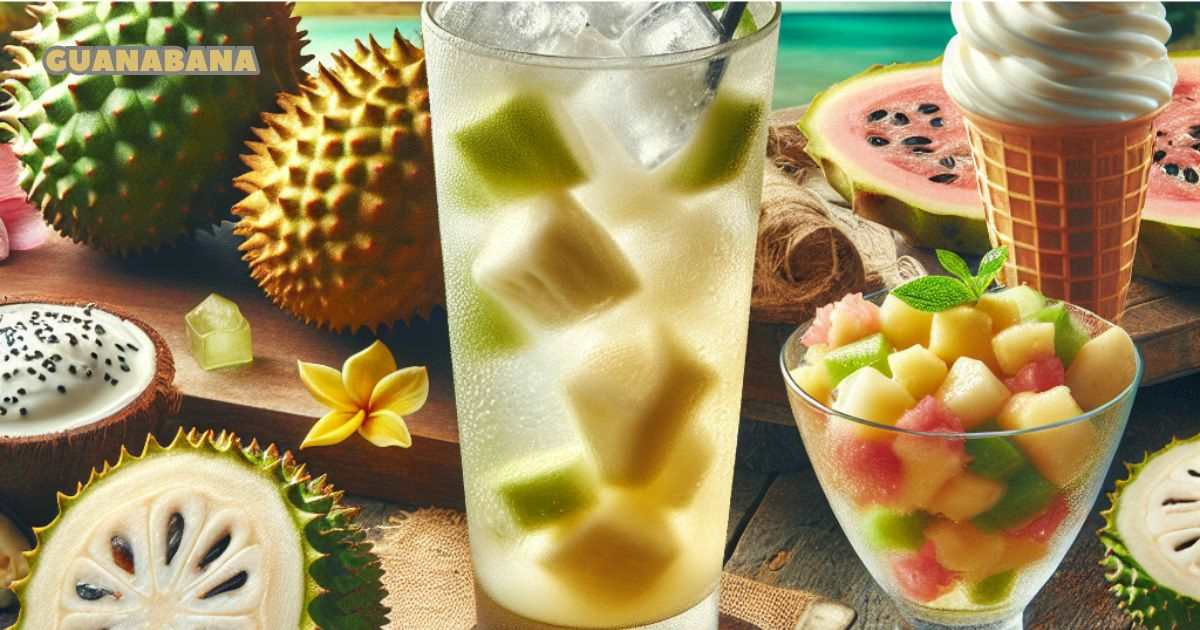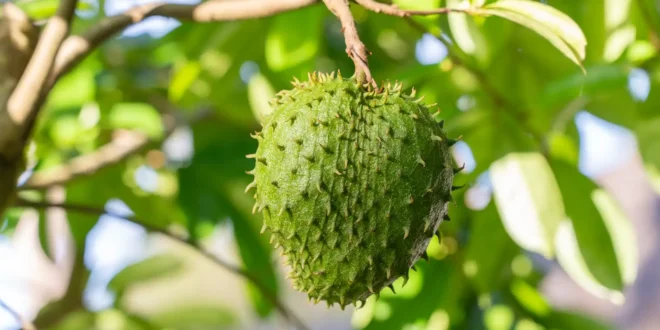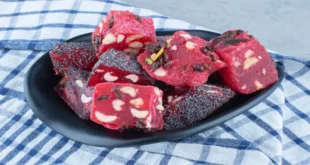Guanabana, also known as soursop or graviola, is a fruit native to the tropical regions of the Americas, particularly in Central and South America. Its distinctive appearance, characterized by a spiky green exterior and soft, creamy flesh, makes it easily recognizable among its tropical counterparts. Beyond its appealing taste and appearance, guanabana boasts a rich history and many health benefits, making it a prized fruit in many cultures worldwide.
Origins and Cultivation of Guanabana (Soursop)
Native Regions and Ideal Growing Conditions
Guanabana trees, scientifically known as Annona muricata, are indigenous to the tropical regions of the Americas. They thrive in warm, humid climates and are typically found in areas with ample rainfall. These conditions are crucial for the optimal growth and fruit production of the guanabana tree. The tropical environment provides the necessary warmth and moisture that these trees require, ensuring they can flourish and yield fruit.
Geographic Distribution
Its trees are cultivated in several countries known for their suitable climates. These include:
- Mexico: Known for its diverse ecosystems, Mexico provides ideal conditions for its cultivation, particularly in its southern regions.
- Peru: The tropical rainforests and coastal areas of Peru offer the perfect environment for these trees.
- Brazil: With its vast tropical landscapes, Brazil is a significant producer.
- Caribbean Islands: The warm, humid climate of the Caribbean islands, coupled with frequent rainfall, makes them ideal for growing Its trees.
In these regions, It is not only a popular fruit for its culinary uses but also valued for its medicinal properties.
Tree Characteristics
Guanabana trees are notable for their distinctive physical characteristics:
- Height: These trees can grow up to 10 meters (approximately 33 feet) tall, making them relatively large compared to other tropical fruit trees.
- Leaves: The leaves of Its tree are large and heart-shaped, providing a lush, green canopy. These leaves are not only important for the tree’s health but are also used in traditional medicine for their purported health benefits.
- Flowers: The trees produce unique, yellow-green flowers that give way to the fruit. These flowers are crucial as they are the precursors to the guanabana fruit.
Fruit Development
The guanabana fruit grows from these flowering trees and is easily recognizable by its:
- Spiky Green Exterior: The fruit has a distinct, spiky green skin that protects its soft, creamy flesh inside.
- Size and Shape: Its fruits can vary in size but are generally large, often oblong or heart-shaped.
- Flesh: Inside the spiky exterior, the fruit contains a creamy, white flesh that is both sweet and tangy. This flesh is segmented and contains inedible black seeds.
Cultivation Practices
Cultivating guanabana requires specific practices to ensure healthy tree growth and fruit production:
- Soil Requirements: Its trees thrive in well-drained soils rich in organic matter. Ideal soil types include sandy loam and clay loam.
- Watering: While these trees require ample rainfall, in areas where natural rainfall is insufficient, supplemental watering is necessary, especially during dry periods.
- Sunlight: Full sunlight is essential for the healthy growth of guanabana trees. They require at least 6-8 hours of direct sunlight daily.
- Spacing and Pruning: Proper spacing between trees is crucial to ensure adequate airflow and sunlight penetration. Regular pruning helps maintain tree health and promotes better fruit yield.
Understanding the origins and cultivation practices of guanabana is essential for appreciating this unique tropical fruit. From its native habitats in the Americas to its careful cultivation in regions like Mexico, Peru, Brazil, and the Caribbean, the guanabana tree’s growth and development are a testament to the intricate relationship between environment and agriculture. By adhering to optimal growing conditions and cultivation practices, farmers can ensure a bountiful harvest of this nutritious and versatile fruit.
Culinary Uses of Guanabana (Soursop)
Guanabana, with its unique flavor and creamy texture, is a highly versatile fruit in the culinary world. It can be enjoyed in a variety of forms, from beverages to desserts, enhancing dishes with its sweet and tangy profile.
Flavor Profile
Its pulp offers a delightful mix of flavors:
- Sweet and Tangy: The taste is often described as a blend of pineapple and strawberry with citrus undertones.
- Creamy Texture: The fruit’s creamy consistency adds a rich, smooth element to any dish it is incorporated into.
Beverages
Guanabana is a popular ingredient in various beverages due to its refreshing flavor:
- Juices: Fresh guanabana juice is a favorite in many tropical regions. It’s often enjoyed on its own or mixed with other fruit juices to create refreshing drinks.
- Smoothies: The fruit’s pulp blends well into smoothies, adding natural sweetness and a creamy texture. Common smoothie combinations include guanabana with banana, mango, or coconut milk.
Desserts
The creamy texture of guanabana makes it an excellent ingredient for various desserts:
- Ice Creams and Sorbets: Its smooth consistency and unique flavor make it a popular choice for ice creams and sorbets. These frozen treats are a delicious way to enjoy the fruit’s refreshing taste.
- Puddings and Custards: The fruit’s pulp can be used to make rich, creamy puddings and custards, offering a tropical twist to traditional desserts.
- Cakes and Pastries: Guanabana can be incorporated into cake batters, fillings, and frostings, adding a unique flavor dimension to baked goods.
Other Culinary Applications
Beyond beverages and desserts, guanabana can be used in various other culinary ways:
- Fruit Salads: Its sweet and tangy flavor complements other tropical fruits like mango, papaya, and pineapple, making guanabana a great addition to fruit salads.
- Jellies and Jams: Its pulp can be cooked down to make jellies and jams, which can be spread on toast or used as fillings for pastries.
- Sauces: Chefs sometimes use guanabana to create unique sauces that can accompany both sweet and savory dishes, adding a tropical flair to the meal.
Guanabana’s versatility in the kitchen makes it a cherished ingredient in many culinary traditions. Whether enjoyed in a refreshing juice, a creamy ice cream, or a decadent dessert, Its unique flavor and texture enhance a wide array of dishes. Its ability to blend harmoniously with other ingredients while standing out with its distinct taste makes it a favorite among chefs and home cooks alike.
Nutritional Value of Guanabana (Soursop)
Guanabana, also known as soursop, is not only celebrated for its delicious taste but also for its impressive nutritional profile. This tropical fruit is packed with essential nutrients that contribute to its reputation as a superfood.
Rich Source of Vitamins
Vitamin C: It is particularly rich in vitamin C, an essential nutrient known for its numerous health benefits:
- Immune Support: Vitamin C plays a crucial role in supporting the immune system by enhancing the function of immune cells and protecting against infections.
- Skin Health: It is vital for the production of collagen, a protein that helps maintain skin elasticity and strength.
- Antioxidant Properties: Vitamin C acts as an antioxidant, protecting cells from damage caused by free radicals.
B Vitamins: It also contains significant amounts of B vitamins, which are essential for various bodily functions:
- Thiamine (Vitamin B1): Thiamine is crucial for energy production as it helps convert carbohydrates into energy. It also supports heart function and healthy nerve cells.
- Riboflavin (Vitamin B2): Riboflavin works with other B vitamins to promote body growth, red blood cell production, and the release of energy from food.
- Niacin (Vitamin B3): Niacin is important for maintaining healthy skin, nerves, and digestion. It also helps convert food into energy .
Additional Nutrients
Dietary Fiber: Guanabana is a good source of dietary fiber, which aids in digestion and helps maintain a healthy digestive system. Fiber can also contribute to a feeling of fullness, which may help with weight management.
Potassium: This fruit provides a significant amount of potassium, a mineral that is essential for maintaining healthy blood pressure levels and proper muscle function.
Low in Calories and Fat: It is naturally low in calories and fat, making it a healthy choice for those looking to enhance their diet with nutrient-dense foods without consuming excessive calories.
Guanabana’s rich nutritional profile makes it a valuable addition to a balanced diet. Its high vitamin C content supports immune function and skin health, while the B vitamins contribute to energy production and overall metabolic health. Additionally, the dietary fiber and potassium found in It further enhance its health benefits, making it a superfood worth incorporating into your daily nutrition.
Medicinal Properties of Guanabana (Soursop)
It, also known as soursop or graviola, has a rich history of medicinal use among indigenous cultures in the tropical regions where it grows. Various parts of the guanabana tree, including the fruit, leaves, and seeds, have been traditionally used to treat a wide range of ailments.
Traditional Medicinal Uses
Infections and Digestive Issues: Indigenous peoples have long used guanabana to treat infections and digestive problems. The fruit’s pulp, leaves, and seeds are believed to possess antimicrobial properties that help combat bacterial and fungal infections. Additionally, guanabana is used to alleviate digestive issues such as diarrhea and constipation
Other Ailments: Guanabana is also used to treat a variety of other health issues, including fever, coughs, asthma, and parasitic infections. In the Amazon, for example, the unripened fruit is combined with olive oil and used externally to treat neuralgia and rheumatism
Research and Controversy
While guanabana holds promise as a natural remedy, especially in alternative medicine circles, its use has also been surrounded by controversy.
Potential Anticancer Properties: Some studies have explored the potential anticancer properties of guanabana, particularly its leaves. Laboratory research has shown that extracts from Its leaves can inhibit the growth of cancer cells in vitro. However, these studies are preliminary, and there is a lack of clinical trials in humans to support these findings conclusively
As a result, while guanabana may have potential as a complementary therapy, it should not be considered a substitute for conventional cancer treatments.
Safety Concerns: There are also concerns about the safety of using guanabana, particularly in large quantities or over extended periods. Some studies suggest that certain compounds in It, such as annonacin, may be neurotoxic and could potentially lead to neurological issues if consumed in excessive amounts. Therefore, it is important to use guanabana with caution and consult with a healthcare provider before using it for medicinal purposes.
Availability and Consumption
It is increasingly available in markets beyond its native regions, thanks to global trade and the growing interest in exotic fruits. In areas where fresh guanabana may not be readily accessible, it is often sold in various processed forms:
Frozen Pulp: Frozen guanabana pulp is a convenient option for those who want to enjoy the fruit’s flavor and potential health benefits without the hassle of dealing with the fresh fruit.
Canned Juice: Guanabana juice is available in canned form, making it easy to incorporate into beverages and recipes.
Powdered Supplements: Guanabana is also available as a powdered supplement, which can be added to smoothies, teas, and other drinks.This accessibility allows consumers worldwide to enjoy the unique flavor and potential health benefits of guanabana, albeit in processed forms.
Its long history of medicinal use and its potential health benefits make it a valuable fruit in traditional medicine. However, while preliminary research suggests promising therapeutic properties, more scientific studies are needed to fully understand its efficacy and safety. As with any natural remedy, it is important to use guanabana responsibly and consult with healthcare professionals, especially when considering it for medicinal purposes.
Guanabana’s Unique Flavor and Texture
It is celebrated for its distinctive flavor profile, which combines elements of pineapple, strawberry, and citrus, with a creamy texture that melts in the mouth. The fruit’s sweet yet tangy taste makes it a delightful addition to various culinary creations, from refreshing beverages to decadent desserts. Its versatility in both sweet and savory dishes highlights its appeal among chefs and food enthusiasts seeking to explore tropical flavors.

The Cultural Significance of Guanabana
It holds significant cultural importance in regions where it is cultivated. It is often featured in traditional festivities and celebrations, symbolizing abundance and vitality. Its use in traditional medicine practices further underscores its role as a revered fruit with holistic benefits. From ancient rituals to modern-day culinary innovations, It continues to weave itself into the cultural fabric of its native lands.
Global Demand and Commercialization of Guanabana (Soursop)
The increasing global demand for exotic fruits has propelled guanabana, also known as soursop, into the international spotlight. This tropical fruit, celebrated for its unique flavor and potential health benefits, is now widely available beyond its native regions.
Rising Popularity
Guanabana’s distinctive taste and nutritional benefits have contributed to its growing popularity worldwide. As consumers become more adventurous and health-conscious, the demand for exotic fruits like It has surged. This trend is evident in various markets, including North America, Europe, and Asia, where guanabana products are becoming more accessible.
Product Availability
To meet the increasing demand, a variety of guanabana-based products have been introduced to the market. These include:
- Juices: Fresh and canned juices are popular for their refreshing taste and health benefits.
- Extracts and Supplements: Extracts and dietary supplements are marketed for their potential medicinal properties, including antioxidant and anti-inflammatory effects.
- Frozen Pulp: Frozen guanabana pulp is a convenient option for consumers who want to enjoy the fruit’s flavor and nutritional benefits without the hassle of dealing with the fresh fruit.
- Ice Creams and Desserts: It is also used in various desserts, including ice creams and sorbets, where its creamy texture and unique flavor shine through.
Economic Impact
The commercialization has significant economic implications for the regions where it is cultivated. The growing demand for Its products supports local economies by creating job opportunities and generating revenue. Farmers and exporters in countries like Costa Rica, Mexico, and Brazil benefit from the increased interest in this exotic fruit.
Key Players in the Market: Several companies are leading the way in bringing guanabana products to the global market. These include:
- Fructo AG
- Raintree Nutrition, Inc.
- Amanaci Rohstoffe UG & Co. KG
- AUSTROFOOD Cia Ltda.
- Flavorah FLV
- Amelia Organic Products
- Harvest Time Foods, Inc.
- ZooScape LLC
- Sunshine Naturals
- Goya Foods, Inc.
- Murugan Pharmacy
- Aseptic Fruit Purees
- Vilore Foods Company Inc.
- NOW Health Group, Inc.
- Jumex Group
These companies are launching various guanabana-based products to cater to the increasing consumer demand. Their efforts not only introduce more people to guanabana’s unique flavor but also support the economies of the regions where the fruit is grown.
Challenges and Opportunities
While the global demand for guanabana presents numerous opportunities, it also comes with challenges. The fruit is extremely sensitive to sudden temperature changes, which can affect its quality during transportation. Ensuring that It reaches consumers in optimal condition requires careful handling and efficient logistics.
Moreover, the commercialization of guanabana must be balanced with sustainable agricultural practices. Farmers are encouraged to employ methods that minimize environmental impact, such as organic farming techniques and biodiversity conservation. These practices help preserve the delicate ecosystems of tropical regions while meeting the growing demand for It.
The increasing global demand for guanabana has brought this exotic fruit into the international spotlight. Its unique flavor and potential health benefits have made it a popular choice among consumers worldwide. The commercialization not only introduces more people to its delightful taste but also supports local economies where the fruit is grown. As the market continues to expand, it is essential to address the challenges of transportation and sustainability to ensure that this tropical treasure remains available for future generations.
Conclusion
In conclusion, guanabana is much more than just a fruit; it is a symbol of tropical biodiversity and traditional medicine. With its delicious taste, nutritional richness, and potential health benefits, guanabana continues to captivate the interest of researchers, chefs, and health enthusiasts alike.
Whether enjoyed fresh, blended into a smoothie, or used in traditional remedies, It offers a delightful way to explore the flavors and benefits of tropical fruits. Its unique flavor profile, combining elements of pineapple, strawberry, and citrus with a creamy texture, makes it a versatile ingredient in both sweet and savory dishes.
As interest in natural health remedies grows, guanabana stands out as a superfood that embodies the harmony between nature and nutrition. Its long history in traditional medicine, coupled with ongoing research into its health properties, underscores its enduring significance in both culinary and medicinal contexts.
Ultimately, Its journey from tropical regions to global markets highlights its importance not only as a nutritious and delicious fruit but also as a cultural and economic asset to the communities that cultivate it. As we continue to explore and appreciate the richness of tropical biodiversity, guanabana remains a shining example of nature’s bounty.
Frequently Asked Questions (FAQs)
What is guanabana and where is it native to?
Guanabana, also known as soursop or graviola, is a tropical fruit native to the Americas, particularly found in Central and South America, and the Caribbean. It belongs to the species
Annona muricata. The fruit is easily recognizable by its spiky green exterior and soft, creamy flesh. It thrives in warm, humid climates with ample rainfall, making countries like Mexico, Peru, Brazil, and the Caribbean islands ideal for its cultivation.
What are the primary culinary uses of guanabana?
It is a versatile fruit in culinary applications due to its sweet and tangy flavor, which is reminiscent of a combination of pineapple, strawberry, and citrus. Its pulp is commonly used to make beverages such as juices, smoothies, and cocktails. The creamy texture of the fruit also makes it a popular ingredient in desserts like ice creams, sorbets, and various other sweet treats. Additionally, its unique flavor can enhance fruit salads and even some savory dishes.
What nutritional benefits does guanabana offer?
It is considered a superfood because it is packed with essential nutrients. It is particularly rich in vitamin C, which supports immune function and skin health. The fruit also contains significant amounts of B vitamins, including thiamine, riboflavin, and niacin, which are essential for energy production and overall metabolic health. Additionally, guanabana provides dietary fiber, aiding digestion, and potassium, which supports heart health, all while being low in calories and fat.
Are there any medicinal uses of guanabana?
Yes, It has a long history of medicinal use among indigenous cultures. Various parts of the guanabana tree, including the fruit, leaves, and seeds, have been traditionally used to treat ailments such as infections, digestive issues, inflammation, and hypertension. While some studies suggest potential anticancer properties, the research is still inconclusive, and it should not be considered a substitute for conventional cancer treatments. Nonetheless, it continues to be valued in herbal remedies and natural health practices worldwide.
How is guanabana made available and consumed outside its native regions?
It is increasingly available in markets beyond its native regions due to global trade and growing interest in exotic fruits. In areas where fresh guanabana may not be readily accessible, it is often sold in processed forms such as frozen pulp, canned juice, or powdered supplements. This availability allows consumers worldwide to enjoy the unique flavor and potential health benefits.
What is the cultural significance of guanabana in the regions where it is cultivated?
It holds significant cultural importance in the regions where it is cultivated. It is often featured in traditional festivities and celebrations, symbolizing abundance and vitality. Its use in traditional medicine practices underscores its role as a revered fruit with holistic benefits. From ancient rituals to modern-day culinary innovations, guanabana continues to be an integral part of the cultural fabric of its native lands, celebrated for both its nutritional and medicinal properties.




